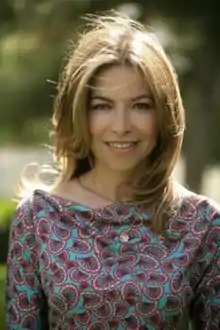King Hussein Cancer Center
The King Hussein Cancer Center (KHCC) (Arabic مركز الحسين للسرطان),[1] is a medical center in Amman, Jordan. It treats both adult and pediatric patients. KHCC treats over 3500 new cancer patients every year from Jordan and the region.
| King Hussein Cancer Center (مركز الحسين للسرطان) | |
|---|---|
| ِAl-Hussein Cancer Center | |
 | |

| |
| Geography | |
| Location | Queen Rania Street, Amman, Jordan |
| Organisation | |
| Care system | Comprehensive Cancer Care |
| Type | Cancer Care |
| Affiliated university | .
Agreements and partnerships:
|
| Services | |
| Beds | 352 |
| History | |
| Opened | 1997 |

The Center was initially named Al-Amal center (hope center) founded in 1997 by the late King Hussein. In 2002, the center was renamed to the King Hussein Cancer Center in honor of the late King who died from cancer complications. The King Hussein Cancer Foundation (KHCF) undertakes various fundraising activities to support and maintain the mission of KHCC as a comprehensive cancer center of excellence. KHCF is a free-standing, independent, non-governmental, nonprofit organization established by a royal decree to combat cancer in Jordan and the Middle East region. The foundation and center is run by a board of trustees consisting of a dedicated group of prominent volunteers and chaired by Princess Ghida Talal. The director general of KHCF is Princess Dina Mired of Jordan and Dr. Asem Mansour is the director general of KHCC.[2]

History
Prior to the mid-1980s, there was no infrastructure for treating cancer patients in Jordan. For quality care, wealthy patients sought treatment abroad, while those without means were treated locally, with limited resources and poor results.
In 1997, the Al-Amal Center, meaning "The Center of Hope", opened its doors. This cancer-specific hospital was established to provide the many patients in Jordan with care comparable to that offered in the West. To honor the late King Hussein, who had died of cancer, the center was renamed the King Hussein Cancer Center in 2002.
In 2006, Mahmoud Sarhan became the director general and CEO of the King Hussein Cancer Center. Dr. Sarhan, a former professor of pediatrics in the Bone Marrow and Stem Cell Transplantation Program at Duke University, was an instrumental figure in the center’s establishment. He founded KHCC's bone marrow transplantation (BMT) program in 2003, a program which has become one of the largest and most successful BMT programs in the Middle East. It is one of the largest (performing approximately 100 bone marrow transplants each year) and most successful programs in the Middle East, achieving cure rates compatible with international standards. The program oversees both matched allogeneic and autologous transplants and performs transplants utilizing cord blood, making it the only program in Jordan and the second in the region that offers such a highly specialized procedure. Other non-cancer cases are also treated through the KHCC BMT program including thalassemia, aplastic anemia and other metabolic diseases.
Accreditations
- Joint Commission International Accreditation (JCI), (February 2006).
- JCI Disease Specific Certification (DSC) - First cancer center outside of the United States, (November 2007).[3]
- Hazard analysis and critical control points (HACCP) Systems and Guidelines for its Application, (April 2008).
- College of American Pathologists Accreditation (CAP), (July 2009).
- Health Care Accreditation Council of Jordan, (August 2009).
International affiliations
- The US-Middle East Partnership for Breast Cancer Awareness and Research: in collaboration with the University of Texas MD Anderson Cancer Center [4]
- St. Jude Children’s Research Hospital, Memphis, Tennessee, USA
- Lombardi Comprehensive Cancer Center of Georgetown University, USA
- Moffitt Cancer Center, USA
- The National Cancer Institute Egypt
- The Hospital for Sick Children, Canada
- The Stefan Morsch Foundation, Germany
- Susan G. Komen for the Cure, USA
- Roswell Park Cancer Institute, NY, USA
Activities
In 2007, KHCF and KHCC were entrusted to lead the first national breast cancer program, Jordan Breast Cancer Program (JBCP), in partnership with the Ministry of Health and other stakeholders. The main objectives of the program are to reduce morbidity and mortality from breast cancer through awareness campaigns, early detection and access to screening for all women in Jordan in order to shift the current state of diagnosis to the early stages of the disease, when it is most curable with high survival rates.
JBCP’s operations are managed by an executive board led by KHCC and KHCF which provides its direction and ensures the implementation of action plans. Princess Dina Mired, director general of KHCF and Dr. Mahmoud Sarhan, director general of KHCC, together chair the Jordan Breast Cancer Committee and the executive board.
In 2010, the King Hussein Cancer Center and the American University of Beirut Medical Center signed a memorandum of understanding to create a joint program in research.[5]
Fund raising expedition to Mount Kilimanjaro

A team of Jordanians went on an expedition to Mount Kilimanjaro in 2014 in an effort to support the cancer research initiatives of the King Hussein Cancer Center and collected $1.3 million.[6][7]
The team was led by Mostafa Salameh; and others include Iman Mutlaq.
See also
References
- ,.
- "Business Real Estate News - Technology - Travel Guide". www.ameinfo.com.
- "Medical Tourism Magazine". Archived from the original on 2011-05-16. Retrieved 2010-09-15.
- "ShareAmerica - Connect with America". ShareAmerica.
- "Business Real Estate News - Technology - Travel Guide". www.ameinfo.com.
- "24 Jordanians to climb Mount Kilimanjaro to support cancer centre". The Jordan Times. August 18, 2013. Archived from the original on December 20, 2014. Retrieved December 3, 2014.
- "King Hussein Cancer Foundation and Center Announces the Launch of a New Initiative to Climb Mount Kilimanjaro, the Roof of Africa". King Hussein Cancer Foundation. August 18, 2013. Retrieved December 3, 2014.
